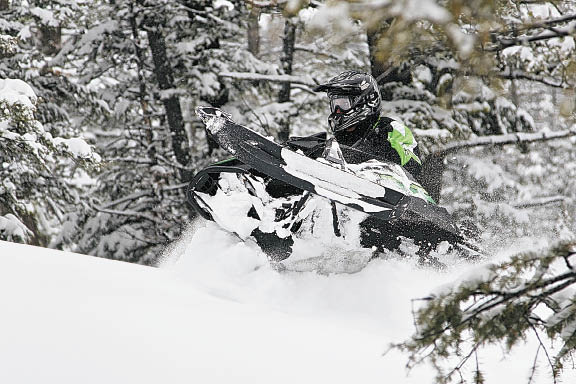 Throughout my 15 years as an instructor in various physically demanding trades and recreational activities, I have found there are three points of common correlation to achieve finesse of a task, no matter what the level of difficulty of obstacles and environment.
Throughout my 15 years as an instructor in various physically demanding trades and recreational activities, I have found there are three points of common correlation to achieve finesse of a task, no matter what the level of difficulty of obstacles and environment.
There are three "Points of Common Correlation" for snowmobile operation. 1) The pilot (human physical and emotional factors combined); 2) the vehicle (gear or machine used during the motion being carried out); and 3) the governor (that which controls the speed and amount of efficient energy of motion to carry out the task easily and safely).
From pulling a fire hose up three flights of stairs into a burning office building, to turns in the backcountry on a snowboard, the factors of these three points need to be in balance to have safe and successful results.
In 2008 I refined my straightforward ABC-123 Curriculum for Backcountry Basics and created a learning platform I call the "Pivotal Pyramid" concept, otherwise known as a Three Points of Common Correlation.
The Pivotal Pyramid is the combination of the pilot (rider input, geometry and body language) the vehicle (snowmobile) and the governor (throttle control and input).
I want to focus on just a few important tips through a very basic exercise that will improve the most complex part of the three, the pilot, better known as the rider. What makes the rider the most complex common of the Pivotal Pyramid is the instinctual psychology that is always present and how it can create a positive or negative result to a rider's physical input, geometry and body language. The key factor that affects this psychology is balance or lack of balance.
The most significant tip I give all my clients about mastering balance is head placement. "Where you look is where you go." This is required for anything we do involving motion and plays an enormous role in rider confidence and situational reactions.
Looking down causes a rider to use more upper body strength or sometimes known as trying to "muscle" the sled. This compromises balance, which in turn decreases confidence, increases respiration and dehydration and directly fatigues the mind and muscles in only a short period of exertion, especially at higher elevations. And that can lead to injuries or accidents.
Over the course of my veteran instructional experience, this is the No. 1 physical input that novice to advanced individuals struggle to overcome correctly. In many cases, this is usually the culprit for advanced riders, holding them back from fluid skill advancement. However, once they overcome it they are usually unstoppable.
If we think about it, even for those individuals without sight, they always lead with the direction of the head leading first. This leading of motion with the head naturally will create good posture and correct balance down into our shoulders, trunk and eventually our legs. A common mistake I also encounter with clients is they sometimes believe they are indeed leading with their head, when in fact they are actually trying to lead with eye movement while their entire head remains stationary.
When a rider is looking where he wants to go it allows for optimal rider input. Newer chassis-like the Arctic Cat ProClimb-are tremendously sensitive to this rider input and allow a rider to have precision directional control through head placement, which in turn will shift rider weight. Transferring all our energy to our lower extremities and maintaining a quiet and rigid upper torso eliminate fatigue commonly experienced by an unconditioned rider. The benefits are maximum upper body core strength while bringing proper lower body alignment to act as a "shock system" that is neutral, relaxed and more loose from the hip joint down to the arch of the feet.
Optimal balance is gained when the balance point is distributed across the arch of the foot and not on the ball or heal region. This is especially important while sidehilling if a rider encounters any impact force of hard snow or obstacles. When the rider is in correct positioning, it allows the impact to be absorbed and displaced equally through the rider's lower extremity region which avoids direct impact injury to the hip or any other joint areas. In some cases, incorrect rider foot placement and balance may displace the rider from the running board completely.
From head to toe, rider input and positioning should work as one. When a rider is looking forward he is processing line of travel information about the environment and his body commonly reacts first through the nervous system long before he traverses the terrain. By looking ahead, the brain has plenty of time to react confidently and appropriately. When a rider is looking down, the result is only good for the reaction time to the present situation, which is normally too late, which creates a sense of not being in control at various levels and that compromises confidence.
Proper head placement will directly affect any fluid throttle control or lack of and how the machine reacts overall. A common result is on and off throttle hesitations and fluid "roll on/roll off" control which can result in becoming stuck and in more serious situations, injuries or accidents.
We will address throttle control more in detail in an issue to follow. Always remember, where you look is where you go.
Holt owns and operates Backcountry Basics and teaches riders of all skill levels how to improve their snowmobiling skills at locations across the snowbelt. For more information,
visit backcountrybasics.com.